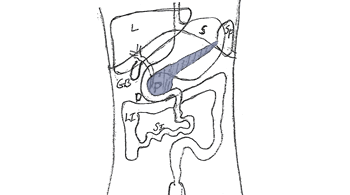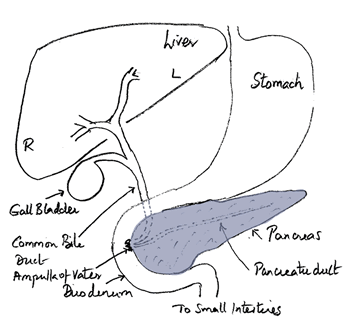This website provides information about Pancreatic Cancer
Associated Sites: livercancer.co.uk | gallstones.co.uk
About the pancreas
The pancreas is an organ in the upper abdomen, about 15 cms (6 inches) long and lies behind the stomach and intestines.
| P | - Pancreas |
| L | - liver |
| S | - stomach |
| Sp | - spleen |
| GB | - gallbladder |
| D | - duodenum |
| LI | - large intestine |
| SI | - small intestine |
It is a gland with a system of ducts and the main pancreatic duct has many small branches and runs the length of the pancreas.
The purpose of the duct is to drain pancreatic juice containing enzymes into the duodenum. The pancreatic duct merges with the bile duct just before it enters the duodenum at the Ampulla of Vater.
The pancreas has two main functions
To digest food by making digestive enzymes which help break down proteins, fats and carbohydrate.
and
To regulate our 'glucose' metabolism by making hormones such as insulin which help to regulate sugar levels in the blood and glucagon which works with insulin to keep blood sugar levels balanced.
This system steadies the level of glucose in the blood. When eating the sugar levels in the blood rise and insulin helps bring them down. Between meals, when sugar levels fall, glucagon helps keep them up.
If the pancreas is removed it will be necessary to take pancreatic enzyme supplements and insulin.

